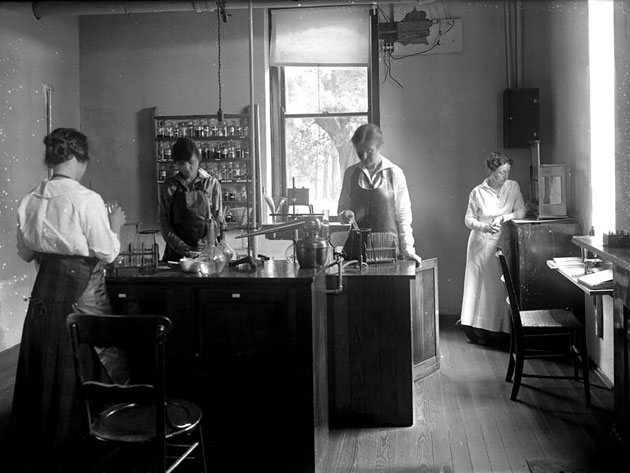
The Kentucky High School Quarterly in 1917 was as
steady and undistracted in its sense of the world and its place in
it as these lab students appear to be. Background conditions were undoubtedly
a factor. When State College became the state's University in 1908,
the responsibility for training teachers for the elementary grades
was reassigned to the "new" normal
schools at Bowling Green and Richmond. The Quarterly reflected
this new institutional division of labor. It was a token of the pride
with which the university's Department of Education shouldered its
new and exclusive mission to prepare high school teachers and superintendents.
Just as significantly, however, the Quarterly was supremely
confident on the issues in the spring of 1917, secure in its enthusiams,
and in what it regarded as levelheaded good sense. In the lead article,
for instance, Mary Sweeny characterized the recent promotion of UK's
Home Economics department to a separate college as "the largest
and most progressive step that has been taken in the interests of Kentucky
women." Writing as the new Dean, Sweeny felt sure that homemaking
had now become "the equal to other professions" -- that a
women with a degree in Home Economics would now "rank with the
man who takes his degree in law or medicine." Or consider the
editorializing of J. T. Cotton Noe in the same issue. Head of the University's
Department of Education from 1912 until it became a college in 1923,
Noe was a poet, someone as famililar to the audiences
on the Redpath Chautaugua circuit as he was to teacher institutes around
the state. He thought of education as an art, not a science, endorsed
testing as long as it furthered the interests of individual teachers
and their pupils, and greeted the school survey -- the premier instrument
of a growing centralized authority -- with a skeptical chuckle. The
aftermath of a school survey, he quipped, was like the aftermath of
a street carnival: "confetti...
confusion... consciousness of a depleted treasury and a few sour stomachs."
On the enormous prestige testing came to enjoy after World War I,
see Stephen Jay Gould, The Mismeasure of Man,
revised and expanded edition (Norton, 1991). On developments after
World War II see Nicholas Lemann, The
Big Test: The Secret Hitory of the American Meritocracy (Farrar,
Strauss and Giroux, 2000).
On the tensions, confusions, and compromises which helped to shape
home economics as a field, see Sarah Stage and Virginia B. Vincenti,
eds., Rethinking Home Economics: Women and History of
a Profession (Cornell, 1997) andd Mareal Nerad, The
Academic Kitchen: A Social History of Gender Stratification at the
University of California, Berkeley (SUNY Press, 1999).
On the political dynamics which transformed normal
schools into state universities, see Jurgen Herbert, And
Sadly Teach: Teacher Education and Professionalization in American
Culture (University of Wisconsin, 1989), David Larbaree, The
Trouble with Ed Schools (Yale, 2004) and Christine A.
Ogren, The
American State Normal School: "An Instrument of Great Good" (Palgrave,
2005).